I made money going long the loonie – that market has turned
Just because you had success with one trade, says John C Burford, it doesn't mean you will have success again by repeating it.
The art of trading takes a long time to learn, just as brain surgery takes many years for surgeons to master. Sadly, many budding traders, armed with the latest software, hardware and with only a passing study of technical analysis, believe they can become master traders practically overnight.
But that is akin to a medical student being allowed to operate on a patient's brain in his first week at university!
Of course, the medical profession is highly regulated and there is a multi-year path of study and practice that must be successfully tested by professors before a student is allowed anywhere near the operating theatre.
MoneyWeek
Subscribe to MoneyWeek today and get your first six magazine issues absolutely FREE

Sign up to Money Morning
Don't miss the latest investment and personal finances news, market analysis, plus money-saving tips with our free twice-daily newsletter
Don't miss the latest investment and personal finances news, market analysis, plus money-saving tips with our free twice-daily newsletter
In the world of trading, there is no such impediment to being allowed near the markets. Anyone with a computer can play in the operating theatre that is the markets. And the analogy is a good one, because most new traders are scalped by the pros and fail their first exam!
Many are called, but few are chosen. I want you to be one of the chosen.
It is my intention in MoneyWeek Trader to help those who wish to put in the time and effort to develop as true traders. That is why these postsare best seen as educational. I use my tramline trading method to show how anyone can learn how to extract profits from the markets.
Of course, not every trade is a winner, but losses are contained by use of strict money management rules, such as my 3% rule and break-even rule.
Learning self-control is key to successful trading
Let me take my recent campaign in USD/CAD as an example.
I last covered it in my post of last Friday ("I beat the herd with two currency campaigns"), where I had just completed the last of my trades.
Recall I had taken the profit on part of my long position and was looking to raise my sell stop on the remainder to take that profit. Last Friday, the market had just exceeded the Fibonacci 62% retrace and was heading back towards my lower tramline. I raised my sell stop to just under that line in case the market decided to retreat beneath it:
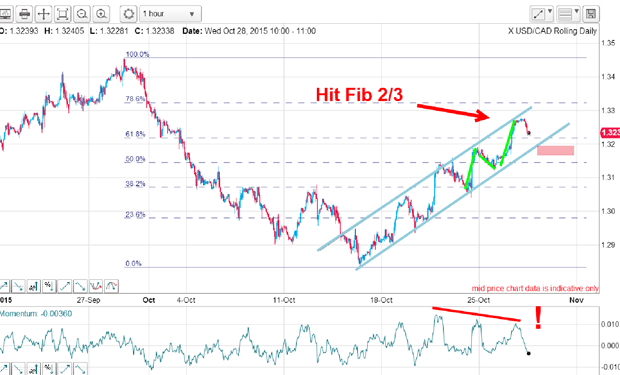
In fact, the market plunged below that tramline and took me out of the last portion of my long position for a profit.
But it rallied back to the tramline, kissed it and started moving lower. Of course, the ideal low-risk trade was to short the market on that kiss low risk because if I was wrong about my forecast for lower prices, a move back inside the trading channel would likely cancel out that outlook:
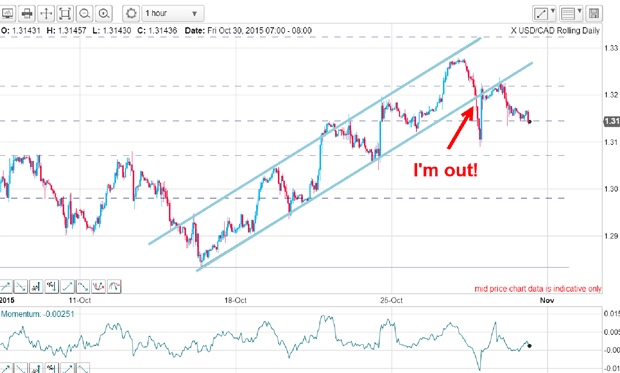
If you missed that entry, how would you feel? You may be luxuriating in the terrific profits you have just taken from trading the long side, and you might well be inclined to look for another long trade after all, the long side has served you very well.
On the other hand, your attention may have turned to another market, and you may have missed the recent action in USD/CAD. If you were to open the chart this morning, this is what you would see:
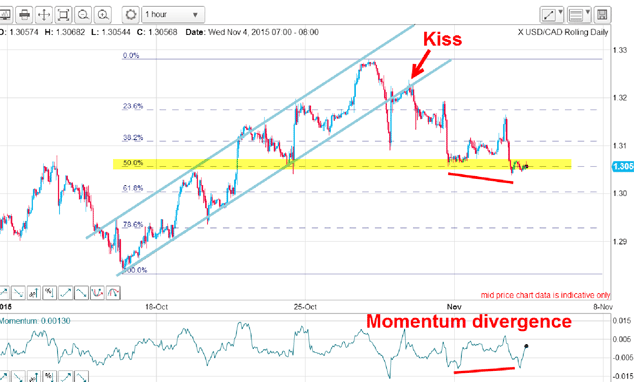
On the bearish side of the ledger, the market has fallen away from the kiss , bouncing back in a near 100-pip rally before falling back yesterday.
On the bullish side, the market has hit support at the Fibonacci 50% level and on a positive momentum divergence.
I can't see an available low-risk trade. And that means I am staying on the sidelines until I can make a solid case to act one way or the other. I am not tempted to try to repeat my former success.
Marrying a trade is no good I'm going short
But I always keep the larger-scale picture at hand and here it is on the weekly:
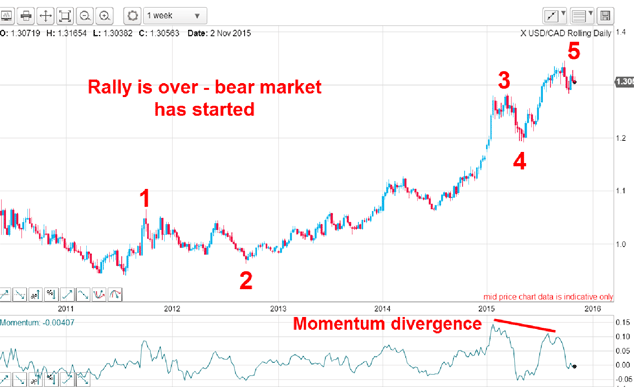
The bull run since 2011 is in a textbook five waves with a large momentum divergence at the wave 5 high. The bear market correction has now started and the major trend is now down.
The wave 5 high was made on 29 September and the first decline was wave 1 of what should turn out to be a five down. The rally to last week's high was wave 2, and the market has started wave 3 down:
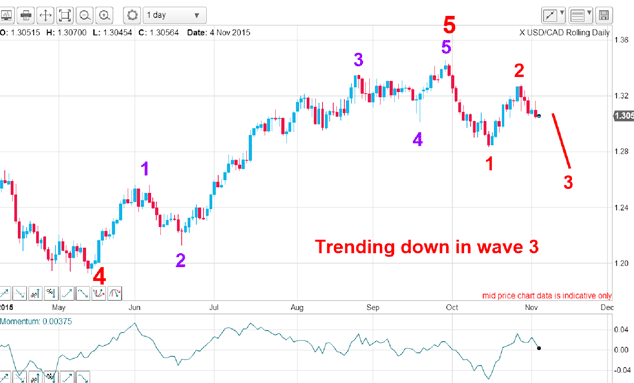
My campaign on the long side was within wave 2, but it appears most of the profit now will come from trading the short side. And that is where I will now concentrate my efforts. Remember, if I am correct and we get a typically long and strong third wave down, the potential profits will far exceed my most recent haul from trading the long side.
Get the latest financial news, insights and expert analysis from our award-winning MoneyWeek team, to help you understand what really matters when it comes to your finances.
John is is a British-born lapsed PhD physicist, who previously worked for Nasa on the Mars exploration team. He is a former commodity trading advisor with the US Commodities Futures Trading Commission, and worked in a boutique futures house in California in the 1980s.
He was a partner in one of the first futures newsletter advisory services, based in Washington DC, specialising in pork bellies and currencies. John is primarily a chart-reading trader, having cut his trading teeth in the days before PCs.
As well as his work in the financial world, he has launched, run and sold several 'real' businesses producing 'real' products.
-
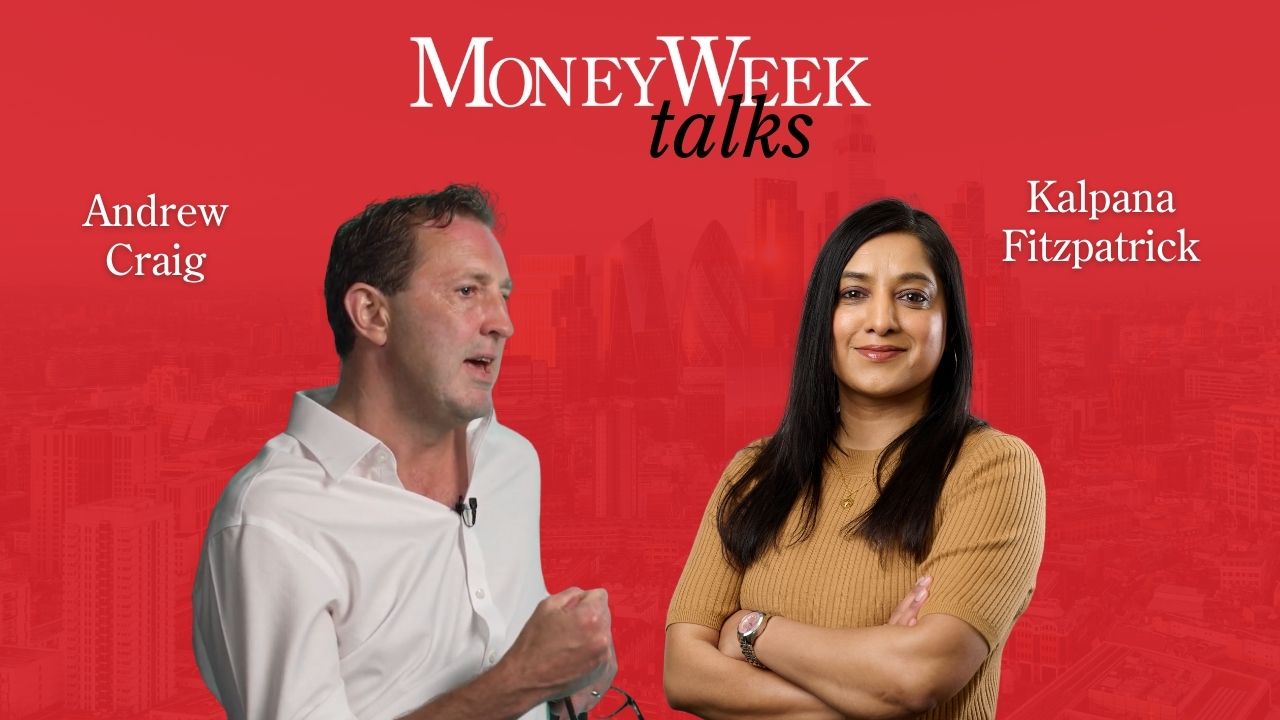 The investing mistakes not to make: MoneyWeek Talks
The investing mistakes not to make: MoneyWeek TalksPodcast MoneyWeek's digital editor speaks to Andrew Craig, founder of Plain English Finance, about why passive investing isn't always the only option for good investors
-
 Household savings ratio drops – are you setting enough aside for 2026?
Household savings ratio drops – are you setting enough aside for 2026?High inflation has pushed the savings ratio down again and the figure could dip further next year